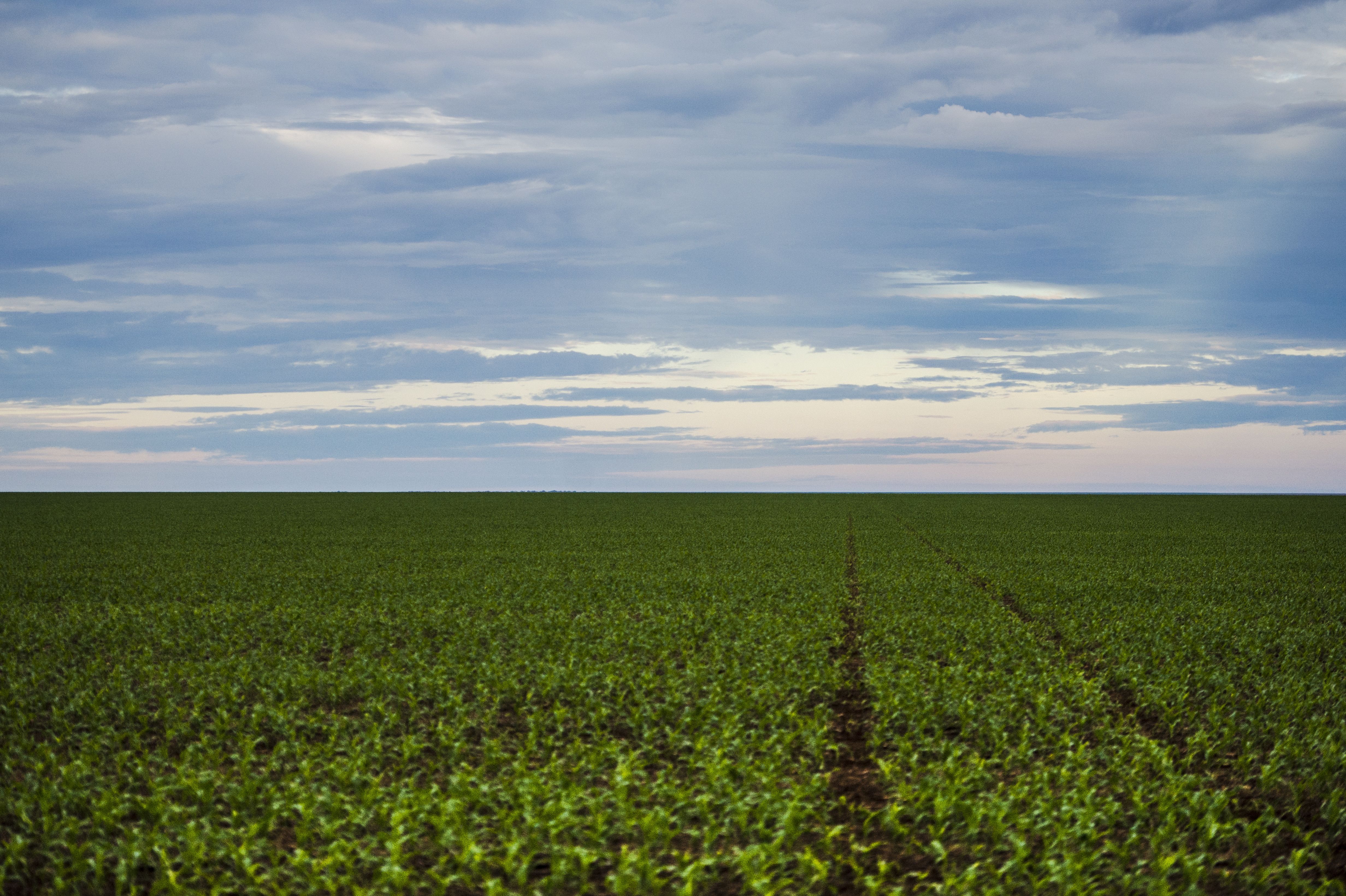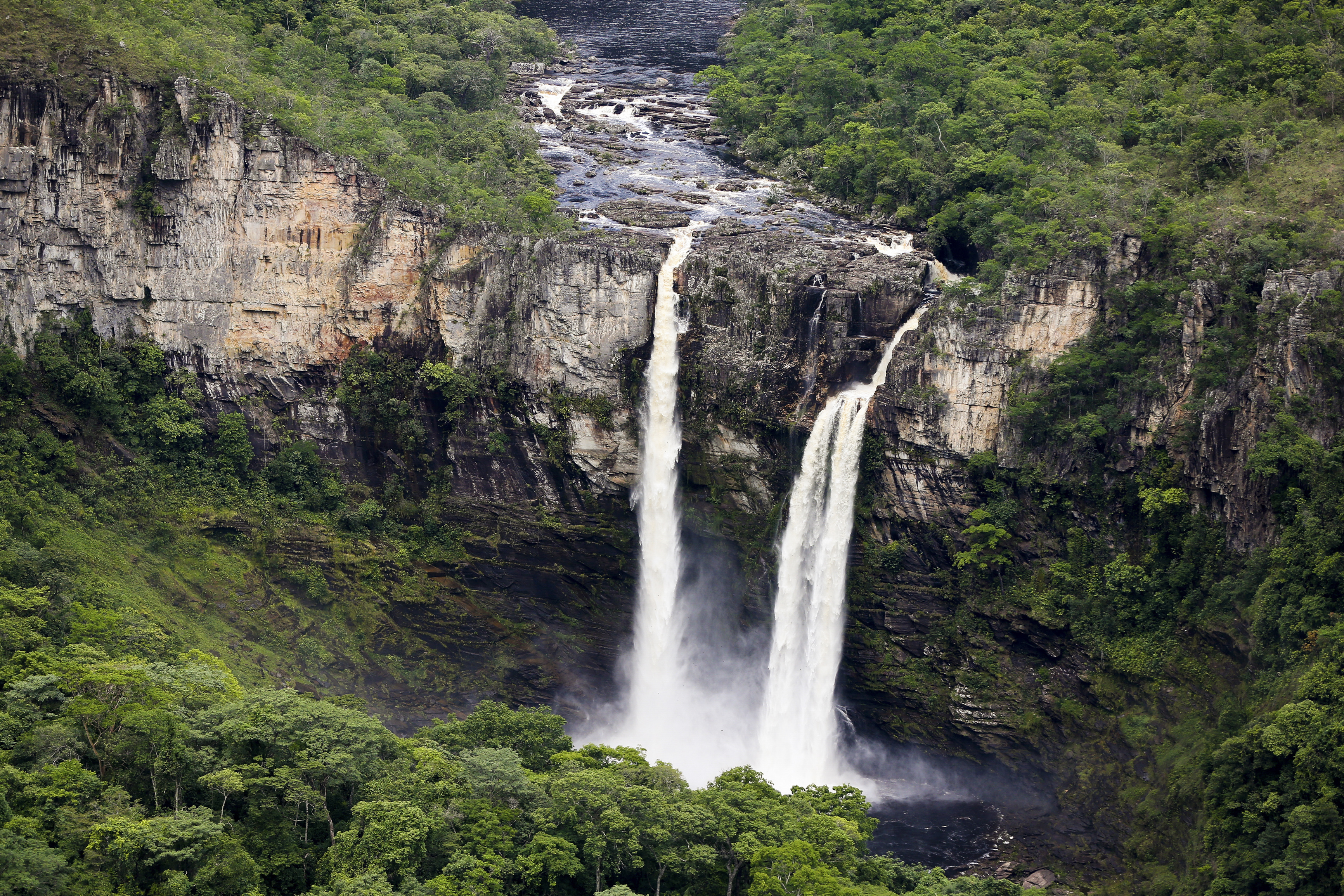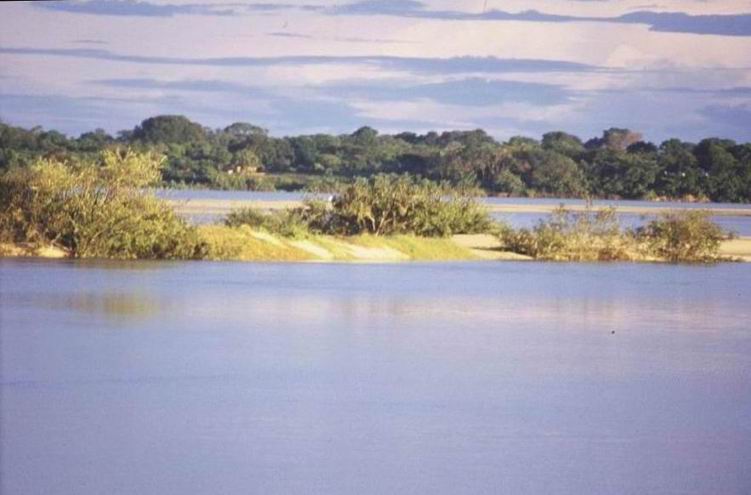|
Serra Azul State Park
The Serra Azul State Park () is a state park in the state of Mato Grosso, Brazil. It protects a mountainous area of cerrado forest and contains slopes that are used for paragliding. The park contains the geodetic center of Brazil. Location The Serra Azul State Park is in the municipality of Barra do Garças in the east of Mato Grosso. It has an area of . The park contains a landmark for the geodetic center of Brazil. The park is in the Guimarães plateau, bounded to the north by the Paranatinga depression, to the east by the Araguaia depression and to the northeast by the Parecis plateau. Altitudes range from at the park entrance to at the highest points. The terrain is rugged, including flatter areas and steep escarpments with slopes of more than 45º. The park is on the bank of the Araguaia River, and is in the Araguaia-Tocantins basin. The mountains give rise to many streams that feed the Araguaia River or the Rio das Mortes. History The Serra Azul State Park was created b ... [...More Info...] [...Related Items...] OR: [Wikipedia] [Google] [Baidu] |
Barra Do Garças
Barra do Garças is a city with a population of 61,135 located in the Brazilian state of Mato Grosso, around from the capital city of Cuiabá. It was founded on 13 June 1924, but it became politically independent on 15 September 1948. Nowadays, Barra do Garças is the 8th biggest city in Mato Grosso. The city is situated on the border between the Mato Grosso and Goiás states and due to this the area is considered a geodesic In geometry, a geodesic () is a curve representing in some sense the locally shortest path ( arc) between two points in a surface, or more generally in a Riemannian manifold. The term also has meaning in any differentiable manifold with a conn ... center. A small but developed tourist city due to high agriculture exportation and a strong military presence, Barra do Garças also has a Cristo Redentor (Christ the Redeemer) statue and is known as ''Rio de Janeiro do Oeste'' (Rio de Janeiro of the West.) The municipality contains the Serra Azul State Park ... [...More Info...] [...Related Items...] OR: [Wikipedia] [Google] [Baidu] |
State Park (Brazil)
A state park () in Brazil is a legally defined type of protected area operated by one of the states. Their goal is to preserve important or beautiful natural ecosystems. Public access is allowed subject to regulations defined by the responsible agency. Definition State parks fall under the same regulations as national parks, defined by law 9.985 of July 2000. The park's basic objective is preservation of natural ecosystems of great ecological relevance and scenic beauty. This enables the conduct of scientific research and the development of educational activities and environmental interpretation, recreation in contact with nature and eco tourism. The park is publicly owned, and private areas included in its limits will be expropriated when it is established. Public visitation is subject to the rules and restrictions set out in Unit Management Plan, rules established by the body responsible for its administration, and those provided for by regulation. Scientific research requires ... [...More Info...] [...Related Items...] OR: [Wikipedia] [Google] [Baidu] |
Mato Grosso
Mato Grosso ( – ) is one of the states of Brazil, the List of Brazilian states by area, third largest by area, located in the Central-West Region, Brazil, Central-West region. The state has 1.66% of the Brazilian population and is responsible for 1.9% of the Brazilian GDP. Neighboring states (from west clockwise) are: Rondônia, Amazonas State, Brazil, Amazonas, Pará, Tocantins, Goiás and Mato Grosso do Sul. It is divided into 142 municipalities and covers an area of 903,357 square kilometers, consequently the state is roughly 82.2% of the size of its southwest neighbor, the nation of Bolivia. A state with a flat landscape that alternates between vast ''chapadas'' and plain areas, Mato Grosso contains three main ecosystems: the Cerrado, the Pantanal and the Amazon rainforest. The Chapada dos Guimarães National Park, with its caves, grottoes, tracks, and waterfalls, is one of its tourist attractions. The extreme northwest of the state has a small part of the Amazonian fores ... [...More Info...] [...Related Items...] OR: [Wikipedia] [Google] [Baidu] |
Cerrado
The Cerrado () is a vast ecoregion of Tropics, tropical savanna in central Brazil, being present in the states of Goiás, Mato Grosso do Sul, Mato Grosso, Tocantins, Maranhão, Piauí, Bahia, Minas Gerais, São Paulo (state), São Paulo, Paraná (state), Paraná and the Federal District (Brazil), Federal District. The core areas of the Cerrado biome are the Brazilian highlands – the ''Planalto''. The main habitat types of the Cerrado consist of forest savanna, wooded savanna, park savanna and grass, gramineous-woody savanna. The Cerrado also includes savanna wetlands and gallery forests. The second largest of Biomes in Brazil, Brazil's major habitat types, after the Amazon rainforest, Amazonian rainforest, the Cerrado accounts for a full 21 percent of the country's land area (extending marginally into Paraguay and Bolivia). About 75% of the Cerrado’s 2 million km2 is privately owned. Vast amounts of research have shown that the Cerrado is one of the richest of all tropi ... [...More Info...] [...Related Items...] OR: [Wikipedia] [Google] [Baidu] |
Paragliding
Paragliding is the recreational and competitive adventure sport of flying paragliders: lightweight, free-flying, foot-launched glider aircraft with no rigid primary structure. The pilot sits in a harness or in a cocoon-like 'pod' suspended below a fabric wing. Wing shape is maintained by the suspension lines, the pressure of air entering vents in the front of the wing, and the aerodynamic forces of the air flowing over the outside. Despite not using an engine, paraglider flights can last many hours and cover many hundreds of kilometres, though flights of one to five hours and covering some tens of kilometres are more the norm. By skillful exploitation of sources of lift, the pilot may gain height, often climbing to altitudes of a few thousand metres. History In 1966, Canadian Domina Jalbert was granted a patent for a ''multi-cell wing type aerial device—''"a wing having a flexible canopy constituting an upper skin and with a plurality of longitudinally extending ribs form ... [...More Info...] [...Related Items...] OR: [Wikipedia] [Google] [Baidu] |
Geodesy
Geodesy or geodetics is the science of measuring and representing the Figure of the Earth, geometry, Gravity of Earth, gravity, and Earth's rotation, spatial orientation of the Earth in Relative change, temporally varying Three-dimensional space, 3D. It is called planetary geodesy when studying other astronomical body, astronomical bodies, such as planets or Natural satellite, circumplanetary systems. Geodynamics, Geodynamical phenomena, including crust (geology), crustal motion, tides, and polar motion, can be studied by designing global and national Geodetic control network, control networks, applying space geodesy and terrestrial geodetic techniques, and relying on Geodetic datum, datums and coordinate systems. Geodetic job titles include geodesist and geodetic surveyor. History Geodesy began in pre-scientific Classical antiquity, antiquity, so the very word geodesy comes from the Ancient Greek word or ''geodaisia'' (literally, "division of Earth"). Early ideas about t ... [...More Info...] [...Related Items...] OR: [Wikipedia] [Google] [Baidu] |
Araguaia River
The Araguaia River ( , Karajá language, Karajá: ♂ ''Berohokỹ'' [beɾohoˈkə̃], ♀ ''Bèrakuhukỹ'' [bɛɾakuhuˈkə̃]) is one of the major rivers of Brazil, and a tributary of the Tocantins River. Geography The Araguaia River comes from Goiás-Mato Grosso south borders. From there it flows northeast to a junction with the Tocantins River, Tocantins near the town of São João. Along its course, the river forms the border between the states of Goiás, Mato Grosso, Tocantins and Pará. Roughly in the middle of its course the Araguaia splits into a fork (with the western stream retaining the name Araguaia and the eastern one being called the Javaés River). These later reunite, forming the Ilha do Bananal, the world's largest river island. The vein of the Javaés forms a broad inland where it pours back into the main Araguaia, a 100,000 hectare expanse of igapós or flooded forest, blackwater river channels, and oxbow lakes called Cantão, protected by the Cantão State Par ... [...More Info...] [...Related Items...] OR: [Wikipedia] [Google] [Baidu] |
Pedro Taques
José Pedro Gonçalves Taques (born March 15, 1968) is a Brazilian teacher and politician. He has previously as governor of Mato Grosso and senator for the same state. Folha de S.Paulo, 05/10/2014 His ticket won against Lúdio Cabral and Tetê Bezerra in 2014
The year 2014 was marked by the surge of the Western African Ebola ep ...
[...More Info...] [...Related Items...] OR: [Wikipedia] [Google] [Baidu] |
Köppen Climate Classification
The Köppen climate classification divides Earth climates into five main climate groups, with each group being divided based on patterns of seasonal precipitation and temperature. The five main groups are ''A'' (tropical), ''B'' (arid), ''C'' (temperate), ''D'' (continental), and ''E'' (polar). Each group and subgroup is represented by a letter. All climates are assigned a main group (the first letter). All climates except for those in the ''E'' group are assigned a seasonal precipitation subgroup (the second letter). For example, ''Af'' indicates a tropical rainforest climate. The system assigns a temperature subgroup for all groups other than those in the ''A'' group, indicated by the third letter for climates in ''B'', ''C'', ''D'', and the second letter for climates in ''E''. Other examples include: ''Cfb'' indicating an oceanic climate with warm summers as indicated by the ending ''b.'', while ''Dwb'' indicates a semi-Monsoon continental climate, monsoonal continental climate ... [...More Info...] [...Related Items...] OR: [Wikipedia] [Google] [Baidu] |
Astyanax Xavante
In Greek mythology, Astyanax (; ''Astyánax'', "lord of the city") was the son of Hector, the crown prince of Troy, and of his wife, Princess Andromache of Cilician Thebe."Astyanax". ''Oxford Classical Dictionary''. Oxford, 1949, p. 101 (''s.v.'' "Ἀνδρομάχη"). His birth name was Scamandrius (in Greek: Σκαμάνδριος Skamandrios, after the river Scamander''A Classical Manual: Being a Mythological, Historical, and Geographical Commentary on Pope's Homer and Dryden's Aeneid of Virgil''. J. Murray, 1833, p. 189.), but the people of Troy nicknamed him Astyanax (i.e. high king, or overlord of the city), because he was the son of the city's great defender (''Iliad'' VI, 403) and the heir apparent's firstborn son. During the Trojan War, Andromache hid the child in Hector's tomb, but the child was discovered. His fate was debated by the Greeks, for if he were allowed to live, it was feared he would avenge his father and rebuild Troy. In the version given by the ''Littl ... [...More Info...] [...Related Items...] OR: [Wikipedia] [Google] [Baidu] |
Bororó People
The Bororo are indigenous people of Brazil, living in the state of Mato Grosso. They also extended into Bolivia and the Brazilian state of Goiás. The Western Bororo live around the Jauru and Cabaçal rivers. The Eastern Bororo ( Orarimogodoge) live in the region of the São Lourenço, Garças, and Vermelho Rivers. The Bororo live in eight villages. The Bororo (or even Coroados, Boe, Orarimogodo) are an ethnic group in Brazil that has an estimated population of just under two thousand. They speak the Borôro language (code ISO 639 : BOR) and are mainly of animistic belief. They live in eight villages in the central areas of Mato Grosso. A famous exponent of this group is Cândido Rondon, a Brazilian army official and founder of Fundação Nacional do Índio (or FUNAI). Bororo's culture was closely studied by French anthropologist Claude Lévi-Strauss during his expedition to Amazonia and Mato Grosso (1935–1936), described in his famous book '' Tristes Tropiques'' (1955). ... [...More Info...] [...Related Items...] OR: [Wikipedia] [Google] [Baidu] |
State Parks Of Brazil
State most commonly refers to: * State (polity), a centralized political organization that regulates law and society within a territory **Sovereign state, a sovereign polity in international law, commonly referred to as a country **Nation state, a state where the majority identify with a single nation (with shared culture or ethnic group) ** Constituent state, a political subdivision of a state ** Federated state, constituent states part of a federation *** U.S. state * State of nature, a concept within philosophy that describes the way humans acted before forming societies or civilizations State may also refer to: Arts, entertainment, and media Literature * '' State Magazine'', a monthly magazine published by the U.S. Department of State * ''The State'' (newspaper), a daily newspaper in Columbia, South Carolina, United States * '' Our State'', a monthly magazine published in North Carolina and formerly called ''The State'' * The State (Larry Niven), a fictional future gover ... [...More Info...] [...Related Items...] OR: [Wikipedia] [Google] [Baidu] |








